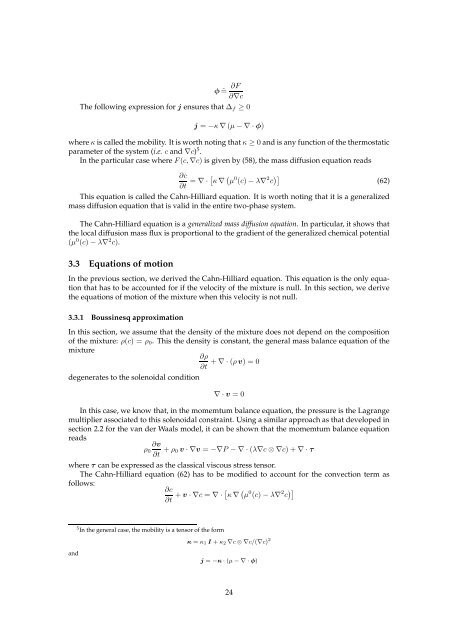Diffuse interface models in fluid mechanics
Diffuse interface models in fluid mechanics
Diffuse interface models in fluid mechanics
You also want an ePaper? Increase the reach of your titles
YUMPU automatically turns print PDFs into web optimized ePapers that Google loves.
φ ˆ= ∂F∂∇cThe follow<strong>in</strong>g expression for j ensures that ∆ f ≥ 0j = −κ ∇ (µ − ∇ · φ)where κ is called the mobility. It is worth not<strong>in</strong>g that κ ≥ 0 and is any function of the thermostaticparameter of the system (i.e. c and ∇c) 5 .In the particular case where F (c, ∇c) is given by (58), the mass diffusion equation reads∂c∂t = ∇ · [κ∇ ( µ 0 (c) − λ∇ 2 c )] (62)This equation is called the Cahn-Hilliard equation. It is worth not<strong>in</strong>g that it is a generalizedmass diffusion equation that is valid <strong>in</strong> the entire two-phase system.The Cahn-Hilliard equation is a generalized mass diffusion equation. In particular, it shows thatthe local diffusion mass flux is proportional to the gradient of the generalized chemical potential(µ 0 (c) − λ∇ 2 c).3.3 Equations of motionIn the previous section, we derived the Cahn-Hilliard equation. This equation is the only equationthat has to be accounted for if the velocity of the mixture is null. In this section, we derivethe equations of motion of the mixture when this velocity is not null.3.3.1 Bouss<strong>in</strong>esq approximationIn this section, we assume that the density of the mixture does not depend on the compositionof the mixture: ρ(c) = ρ 0 . This the density is constant, the general mass balance equation of themixture∂ρ+ ∇ · (ρ v) = 0∂tdegenerates to the solenoidal condition∇ · v = 0In this case, we know that, <strong>in</strong> the momemtum balance equation, the pressure is the Lagrangemultiplier associated to this solenoidal constra<strong>in</strong>t. Us<strong>in</strong>g a similar approach as that developed <strong>in</strong>section 2.2 for the van der Waals model, it can be shown that the momemtum balance equationreadsρ 0∂v∂t + ρ 0 v · ∇v = −∇P − ∇ · (λ∇c ⊗ ∇c) + ∇ · τwhere τ can be expressed as the classical viscous stress tensor.The Cahn-Hilliard equation (62) has to be modified to account for the convection term asfollows:∂c∂t + v · ∇c = ∇ · [κ∇ ( µ 0 (c) − λ∇ 2 c )]5 In the general case, the mobility is a tensor of the formκ = κ 1 I + κ 2 ∇c ⊗ ∇c/(∇c) 2andj = −κ · (µ − ∇ · φ)24











![[Diffusion-Limited Aggregation - A Model for Pattern Formation].](https://img.yumpu.com/52395246/1/190x245/diffusion-limited-aggregation-a-model-for-pattern-formation.jpg?quality=85)




